
This is a card of initiation and excitement, especially when it comes to a topic or endeavor you're passionate about. I posted these originally on Mastodon... I don't have to convince anyone I think that free and open source are compelling ideas and ethos-es that many have put their inspiration and passion into... sometimes only that, to certain drawbacks.
Can a person represent an idea that big, even if they've contributed a lot to it? Is it good to put someone in that position, where there's the risk of them doing/saying something awful, becoming possessive or doctrinaire about it, or just having a way of going about it that doesn't gel with everyone? Can passion create monsters, or at least very unpleasant situations?
I'm having these thoughts at the end of this journey; a lot of these cards were specific historical figures or events. And I think it's good to rediscover and be inspired by them, but we also can't elevate them to the status of an icon. Transplanted into the present, they wouldn't respond to the way things are -now-, even if we can learn a lot from them or build on their ideas. There's no easy solution we can just extract from the past like a diamond in a mine... in some ways the future is unforeseeable even as we do what we can to build it.
THE END!!! This was fun. I want to practice with my Colman-Smith deck more and maybe figure out more stuff to do with these... this month of draws used less than half of the cards in the deck!
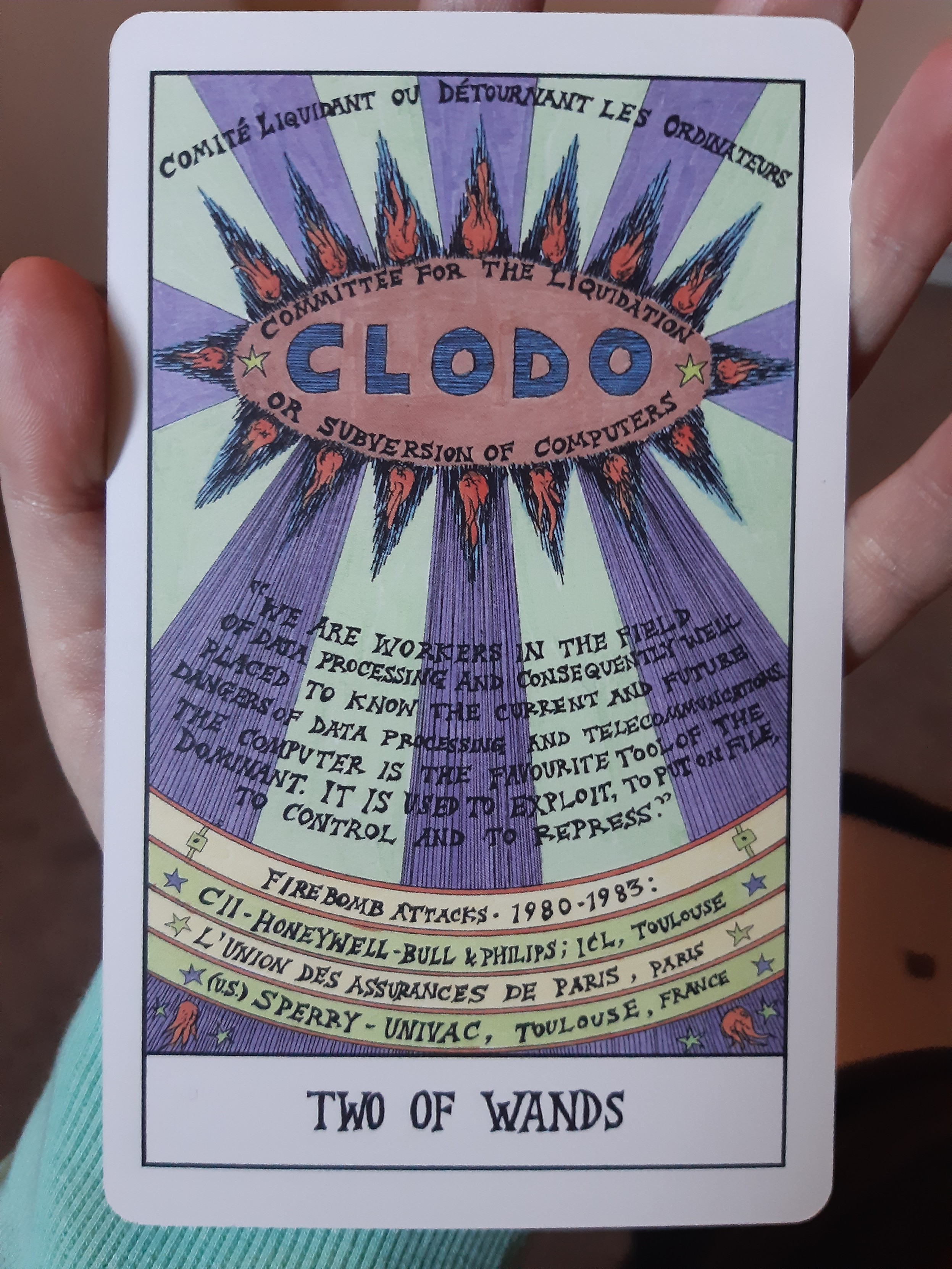
Potential, planning, and the decisive moment of departure...
As someone who loves both sabotage and detournement, I was kind of delighted to find out about this group. Tonight we also watched Cindy Sherman's only feature film, Office Killer, which is also in part about the consequences of digitalization on workers.
Eliminating computers altogether but trying to do the same work... as a textbook editor I imagine there would be elements that would become now, so tedious and slow relative to my expectations that it might be psychologically unbearable. In some senses I've acclimated to a lot of what distressed people at the time of its introduction.
But at the same time, we're living in the consequences of broad information technology adoption, from increased precarity to the ease of tracking and rounding up visa recipients. We're more intimately entangled with computing, so the ways we sabotage or detourn these systems for our own purposes my be more complex, but the important thing is to plan, have a vision and, somehow, step over the threshold...
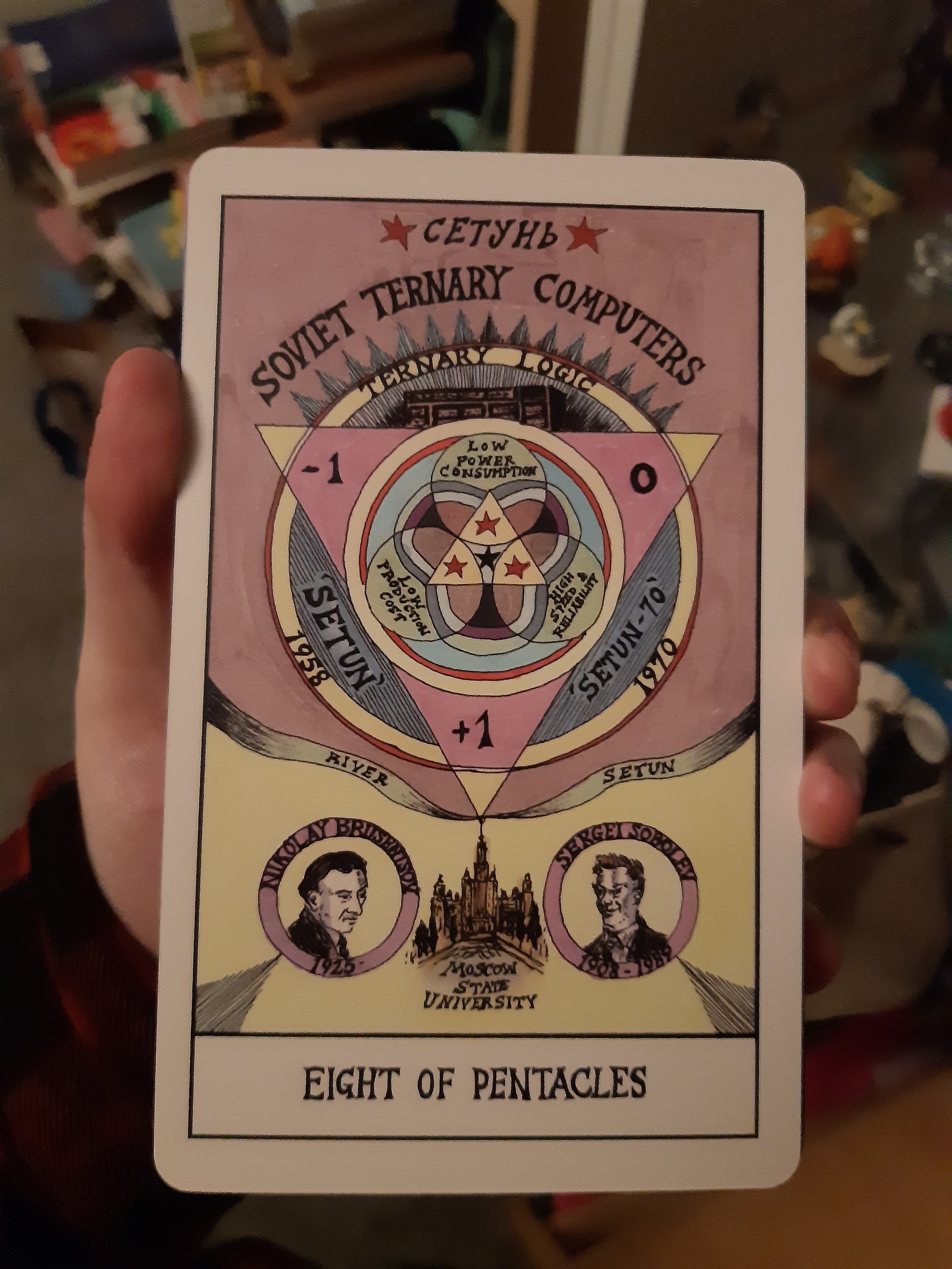
A card for learning, dedication and effort. Here it is an alternate path computing could have taken, the Soviet ternary computers.
I don't have a very technical or mathematical mind, even though I get really into scripting and programming once I understand the rules. When I found out, for example, that different societies had different base- numerical systems (other than base 10), no matter how many times people explained it or demonstrated it to me, I couldn't really make sense of how you could count or do math in a system like that, I'm so locked into the idea of 10s.
Similar to alternative protocols for the internet, I don't fully understand what the implications of ternary (rather than binary) computing would be in a practical sense. But it's very conceptually interesting. Has the binary nature of tech (where something either is, or is not) also spread to, within tech, how we categorize, analyze, measure success or failure? It's very amenable to capitalist metrics and also, well, every bad binary invites the mapping of all other binaries onto it. It can seem self-evident while being an entirely ideological process.
Not positive, not negative, but a third secret thing. The power of being able to say, no! Neither! Sometimes it feels like that, more than anything, is what's being taken away...

Progress, and moving forward with wisdom and foresight.
This particular card was like seeing an old friend, OMG, ListServ!! Metamute! Rhizome!! When I think of sites and infrastructure like these, that's what was... and is, exciting about the internet to me. To think that some people just scroll the walled garden social media of their choice, feel bad, and decide "the internet is bad" is, david lynch voice: such a sadness!!
I run my email newsletter through a listserv host because I don't think any of these trendy new newsletter platforms are going to be around that long, or they're just openly the funded cultural circuit for fascists. Still, it's undeniable that the things here which are not totally defunct have been significantly wound down by how the internet changed, from their peaks of activity.
There's the routine call: Go back to forums! And I've tried this, but one has never reached the level of interest and regularity for me that it lasted. Same for non-substack grift email newsletters, and, while I am a big believer in homepages, there's a lot less sense of being linked to and read by others than there was even a few years ago... It doesn't make me think social media is -good- of course, but it does make me wonder...
These platforms all displayed wisdom and foresight, but something about their times have passed... What can we learn from them to build our own momentum going forward?

A card of feminine authority, motherly care.
Like any system that thrives on bad binaries, the State, to reassure everyone that it's better to be Us than Them, has to wield both daddy's "masculine aggression" and mommy's "feminine protection."
When it came out earlier this week that the careless US administration had leaked military positions and plans to a random journalist by accidentally adding him to a Signal group chat, the worries online seemed to coalesce around what other information could, or had already, gotten out, rather than questioning if blowing up a random building in Yemen really has any practical connection to our "security" at all.
Mommies can make you -feel- safe, but they also discipline, imposing the rules of obedience to family roles that enable so much chauvinism and cover for child abuse. The idealization of mothers is just another turn in the wheel of reinforcing gender roles. Do we really need these mommies? Is their protection doing us any good?
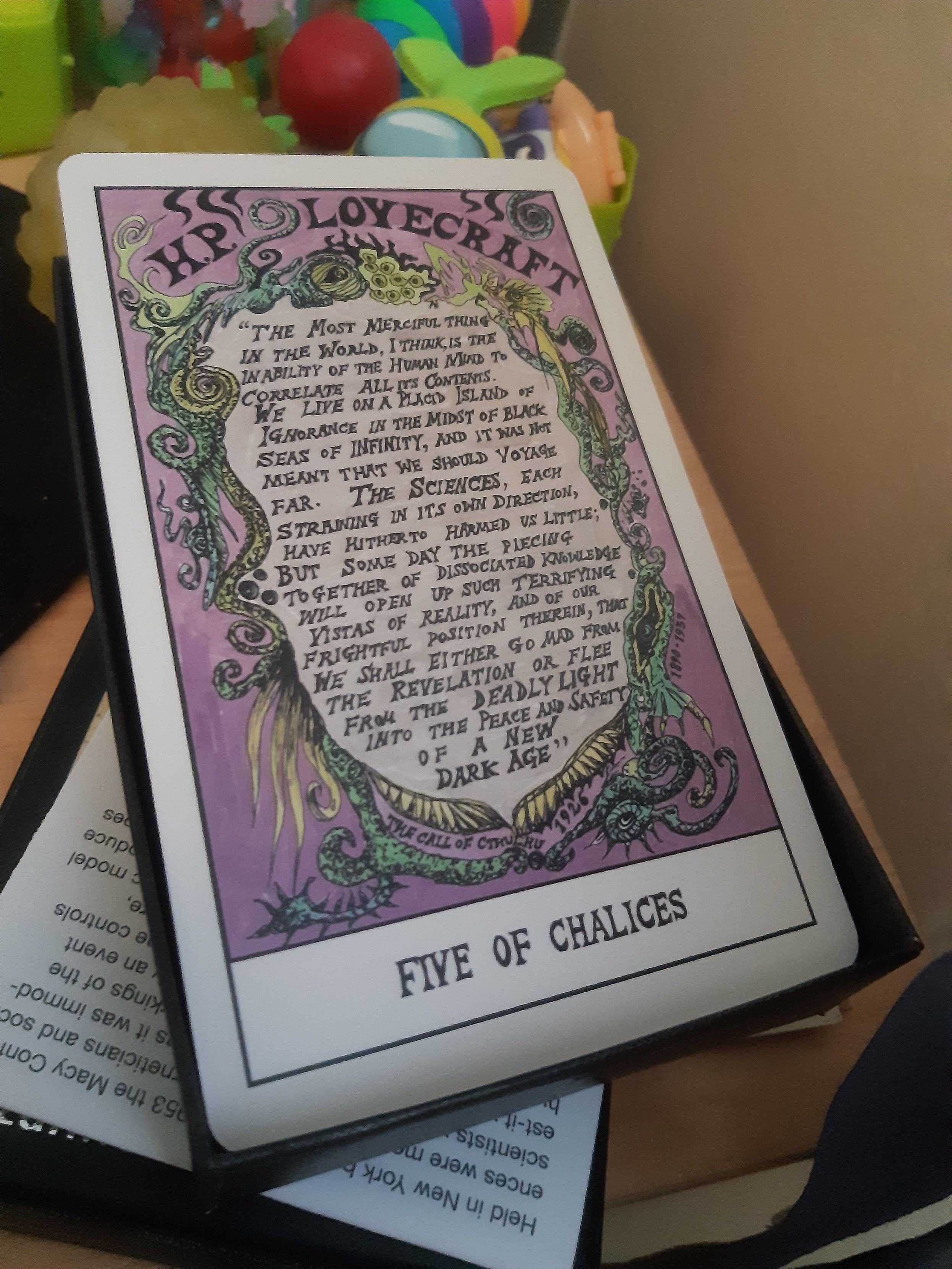
One of the most interesting cards to me. A gloomy card representing pessimism and lost opportunities. And here it is the arch-pessimist HP Lovecraft.
Obviously I love several famous pessimists, most notably Adorno, and find it an interesting perspective within a culture where the expectation is that making a claim is to affirm. It can be cutting in the face of a lot of simplistic tech hype and optimism to simply refuse, to puncture all their inflated claims.
But I also find HP Lovecraft's particular strain of pessimism to be a sort of self-centered and childish one. Particular analysts whose work I find a bit silly where it isn't outright regressive seem to love this particular quote (while I, for one, find the conditioned suggestibility that seems to accompany these types to be a far bigger risk than knowledge or information itself), and while Lovecraft as an author seemed to be able to stumble on an occasional interesting image in an ocean of kludge, successors with a smidgen of sensibility have been able to do more interesting stuff with his work.
So this card is kind of a warning to me, that pessimism can become just as facile and serve unexamined ends as optimism. I started doing these tarot draws out of a desire to evaluate my relationship to technology, not to pile up justifications to abandon it-- in that case why not just drop it? The easy initial reaction, whether positive or negative, is just that... reaction. And Pamela Colman Smith gave us two cups still standing in addition to the three that were spilled...
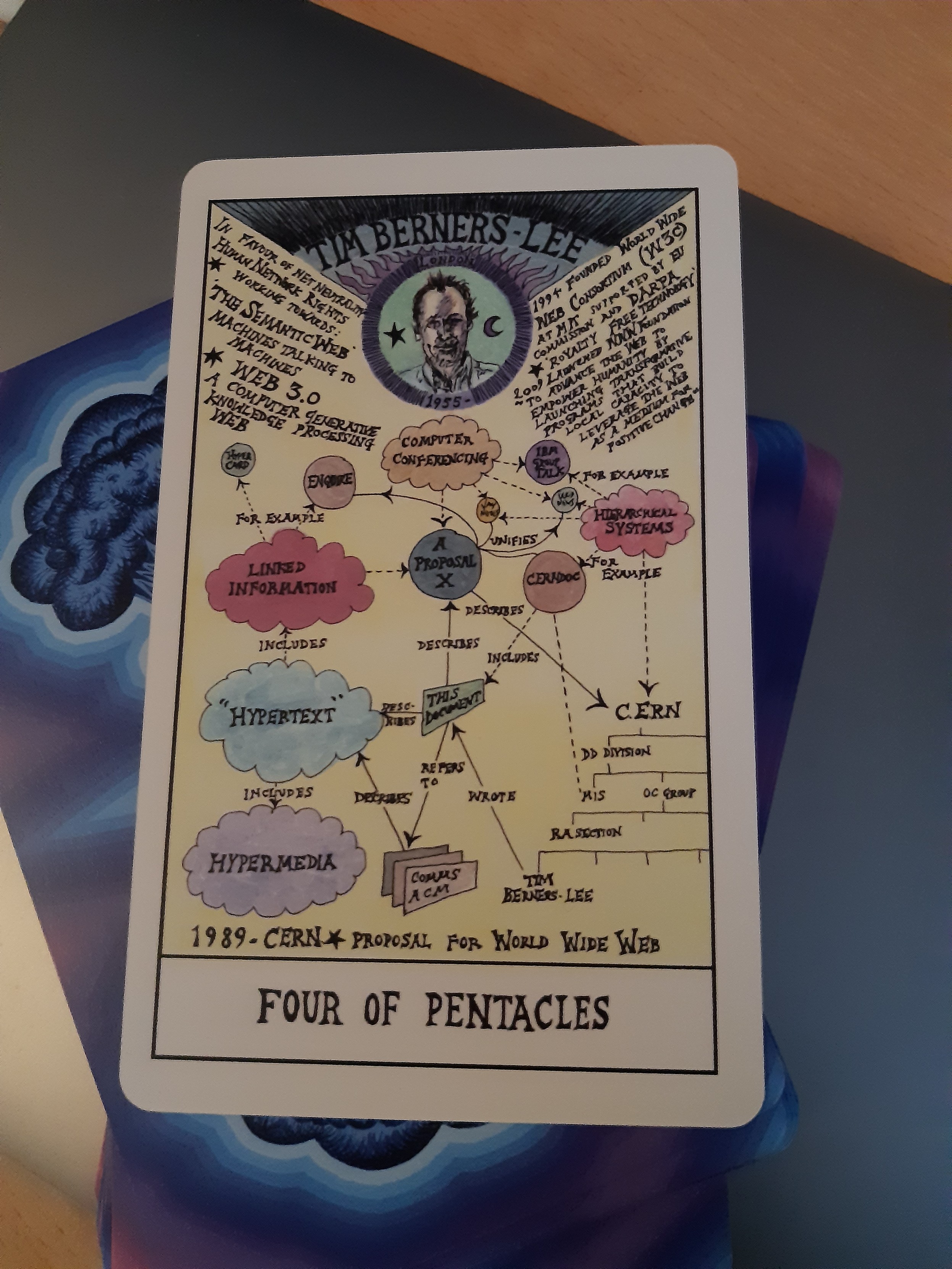
This card can represent protecting the spoils of a great success, but also possibly becoming possessive, greedy or overly rigid.
Obviously the web was a transformative idea that became a foundational aspect of many of our individual lives, not to mention how communication, logistics, research and so on are now carried out around the world. It's also become resource-hungry, fragmented by social media platforms, more gigantic and serving more varied purposes than I think even its most aggressive boosters would have predicted.
On the other hand, when "move fast and break things" is the mantra of the platforms, who would love to have more ways to create walled gardens and company towns, sticking to your slow moving, tedious principles may have some benefits...
Though of course a lot of people let DARPA or similar institutional figures with money to throw around in the back door in the name of "stability," but what possibilities or positions of strength do you lose, when you sell yourself off like that, or become a part of the institutions?
I know I'm at the very bottom level of this, not sure how significant changes to these protocols would impact posting online and managing my own simple homepages. Yet I'm still kind of a "nerd" in that sphere-- these processes are so much more opaque to many, many more people.

Completion of cycles, wholeness... the totality, perhaps.
A coy card... a funny card... a mysterious card. Could it be taken like the old joke, that whatever comes after what the World Wide Web brings about will have to be settled with sticks and stones? Or, in the Metal Gear Solid sense, does a networked society equal the movement away from large scale warfare with strictly drawn alliances and battle lines to a constantly shifting series of proxy wars and unconventional conflicts?
Or, does it simply mean that these gigantic shifts that determined the shape of technicity-- codebreaking, biopolitics, advanced weaponry and game theory, then networked finance-- throughout the cycle of the 20th century? What will the 21st look like, then?
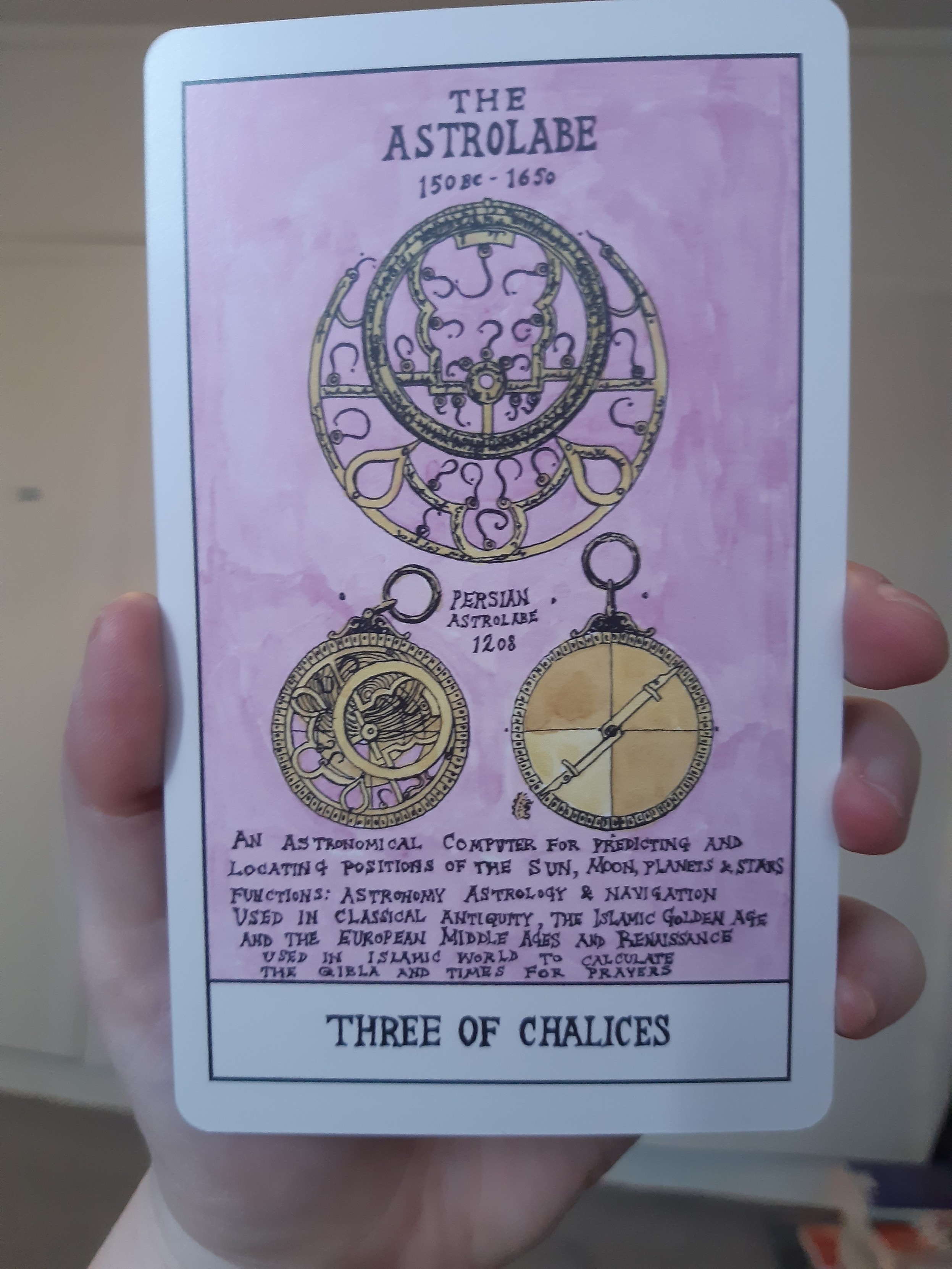
A card of creativity and collaboration! Cool.
The Astrolabe is one of the oldest and most overlooked predecessors to digital computing... it's also wild to imagine their use spanning from 150 BC to the Age of Enlightenment. Like the equally impressive old school water clocks and earthquake detectors, the complexity and capability of these devices show that humans were working together on problems and preserving and passing down knowledge long before digital technology or even what we now consider empirical science.
There's also something more open and friendly about devices that just, in themselves, work. They feel admirable, like something that works with you, and that you can build on and fix yourself. Many of these amazing devices, if they don't come to us in the present intact, can be understood or even rebuilt from the pieces and schematics left behind... how much of modern computing is this true about?
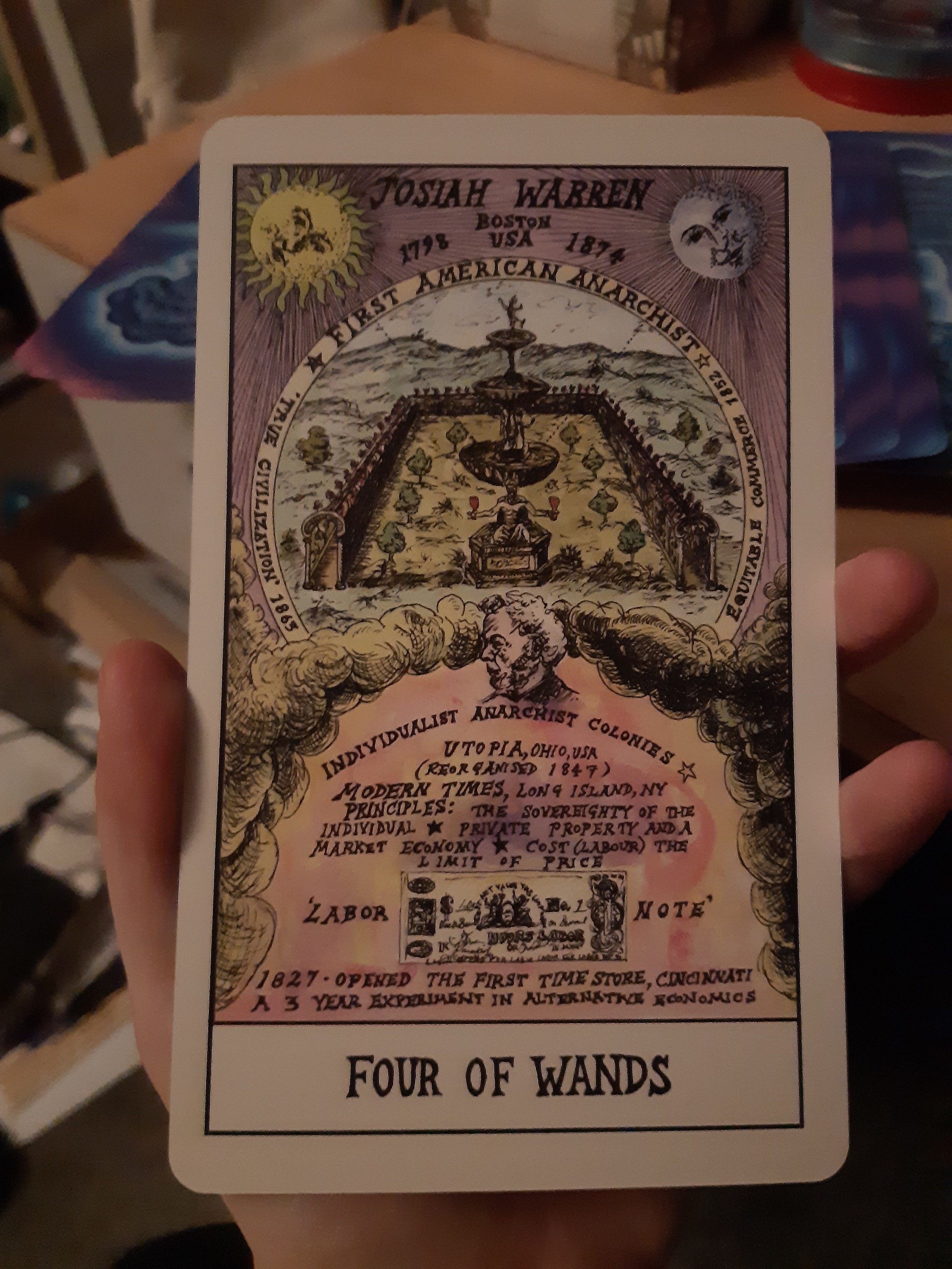
(Counting down I guess) A card representing harmony and relaxation.
It's obvious that financial capitalism and the wage labor system don't adequately capture "value," the majority of money is put into purely abstract and pointless shit and the people who do the most work are usually the least able to take any time off...
There's a temptation to say, if only we could get the variables right, it would work in all cases. Prosperity and harmony for all and world peace. Whether that's perfectly calibrating wage or price to precise time worked, or something as subjective as "effort" or "skill"...
I love to consider alternative economic arrangements but feel like "solving" the problem of value is a bit of a crank charybdis, in the sense that you can put infinite thought into it... but does it matter when currency itself is already the "false coin" of concrete needs, experiences, resources, skills etc sold back to us incomplete? Can a system like that ever reach a harmonious equilibrium? or is it always something that will end up being gamed...

Conflict, here represented by one of the OG weirdos William Blake.
An eternal topic for me is, of course, the role of art amidst culture, politics, and technology... a term, starting in part with the romantics, that expresses such an absolute alliance to autonomy and hostility to use-value that it inevitably attracts conflict-- about what it should do, should mean, whether it's irredeemably individualistic or wasteful to pursue...
I have to wrestle with these questions and resistances to be able to express my own values. Again the Adorno idea-- if everything can be known empirically/materially, then why doesn't knowledge have a philosopher's stone like power to persuade and enact change? Do we just sit on our hands and say the world "should" do as we say? Or do we have to consider that our enlightenment may seem just as naive and wrongheaded as beliefs and actions throughout the enlightenment of the 1700s seem to us now? How do we get in touch with what we don't even know we don't know?
I guess that's my personal justification for art that surprises me, expresses something at once alien but clarifying... it puts me back in my place.
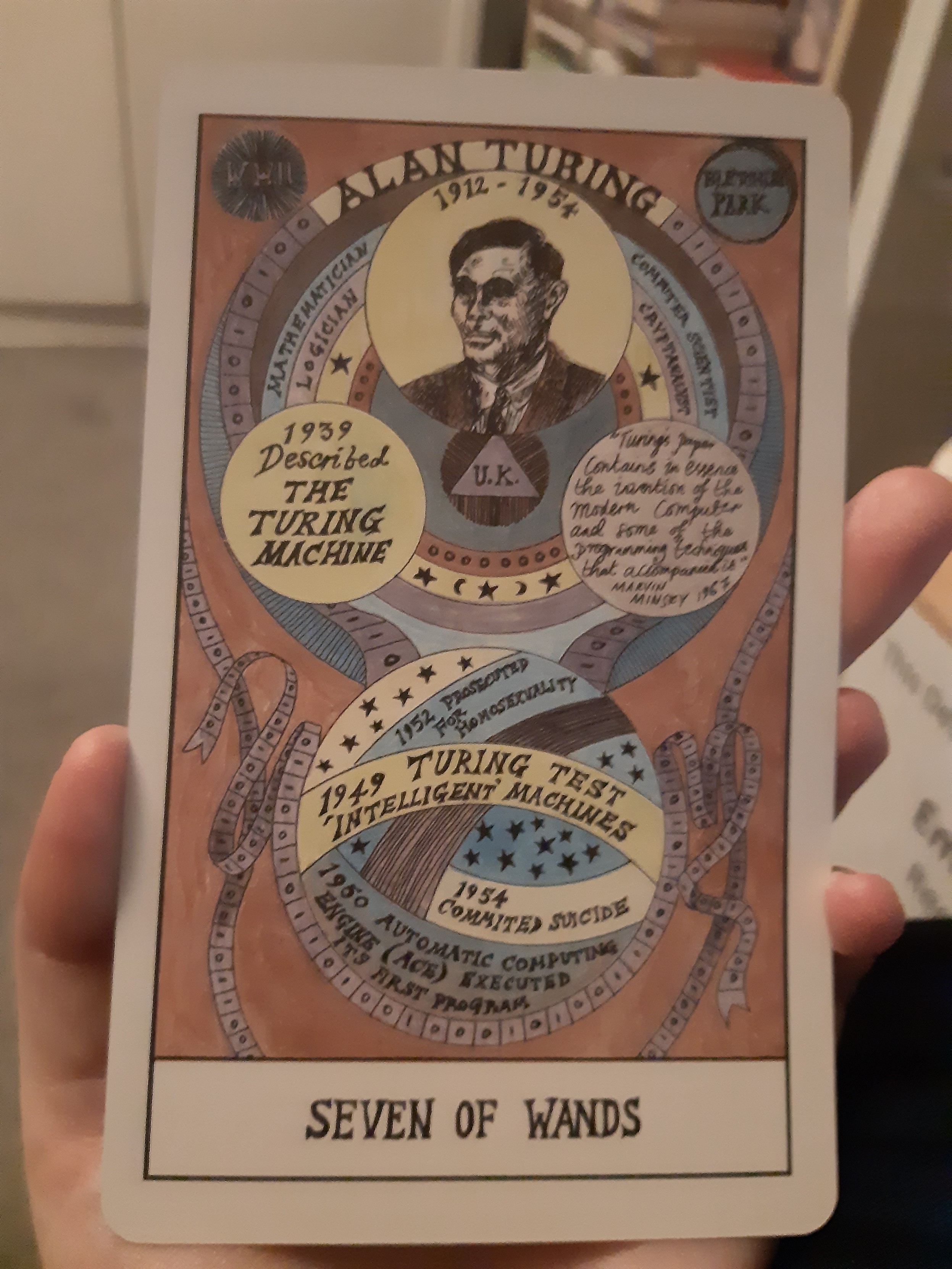
Happy Equinox! Here's a card for facing challenges and holding on to your beliefs.
If you don't just unquestioningly sell out in tech, you'll probably end up discarded; countless people who made essential contributions to the form technology takes today are written off as cranks, treated like a wrecker, or pushed out by the white, patriarchal, heteronormative, wealthy tech culture for not falling unobtrusively in line, role-playing an interchangeable cog on the automated treadmill of progress.
Despite this, it's always the most important time to hold onto our beliefs, and challenge everything that would deny our vision of tech worth living alongside, and to not lose sight of our values in a world that tries to devalue acting on ideas and principles. It's the only way.
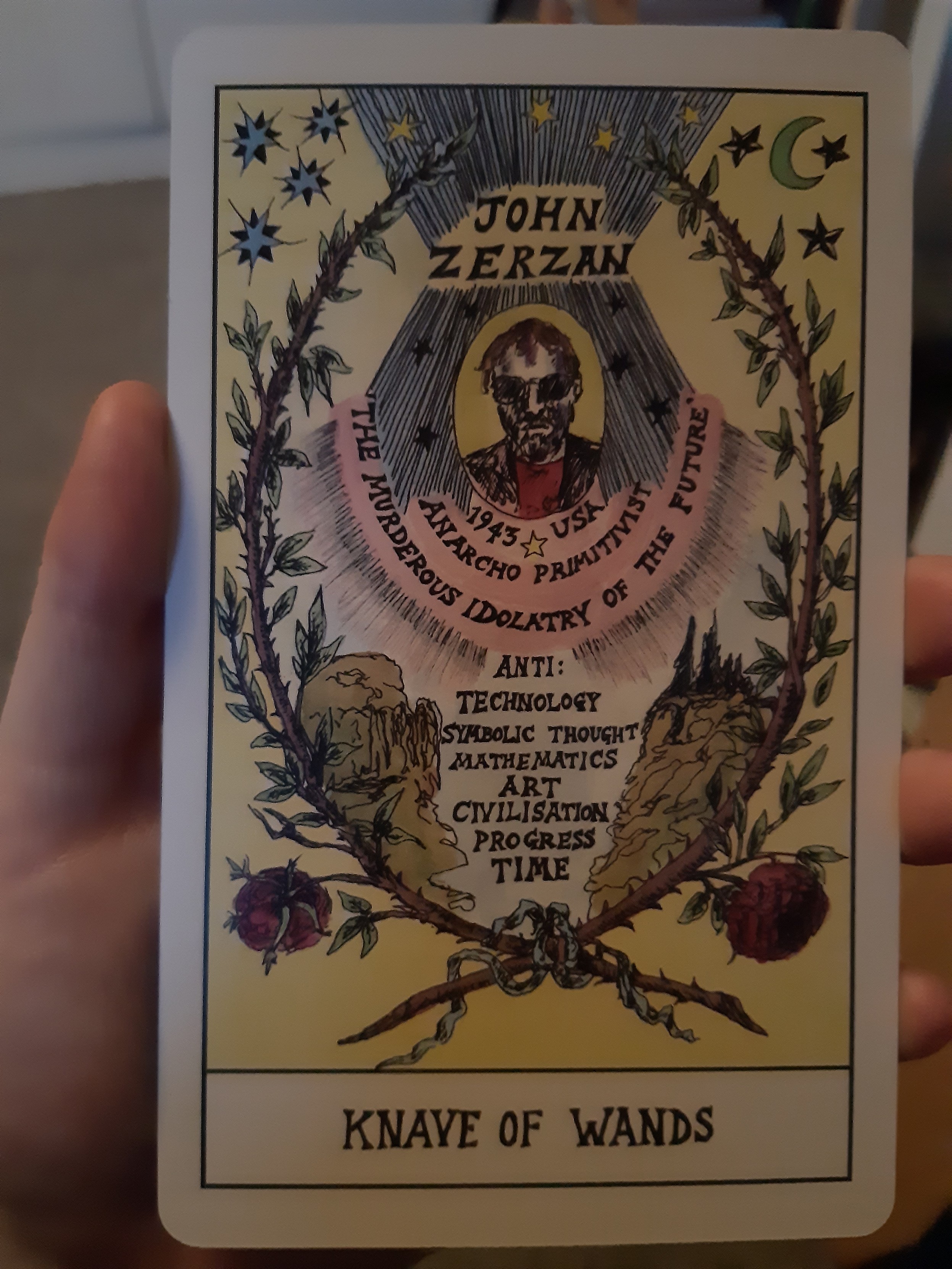
New ideas and adventure.
Feels like kind of a funny time to draw this one, since the more anti-civ strands of anarchism are like, eternal fixtures for online rubbernecking and bad faith dunks. They're just so naive, right?
I said before, I feel like this exercise has me ultimately feeling less anti-tech than I thought I would. I find a lot of the recent luddite-inflected rhetoric kind of underwhelming precisely because they lack the analysis that even the most outre or objectionable anti-civ positons actually have. It's just about how "the phone" or "online" feels bad, or some dull moralizing or normative argument about Art or the Dignity of Labor or whatever and then therefore it can only be bad. Which is not really convincing if there's way it feels good, right? And never mind structuring it or doing anything different with it, we just have to sit on our hands continuing to feel bad because, "it's addictive" or "I might win the precarious freelance byline lottery."
Even if they're not personally practicable or desirable, I find engaging with these positions more interesting than the people who reflexively make fun of them do-- to be presented with a thorough argument for what is not -strictly- necessary, though it may be presented as such, forces you to examine and maybe even shift your own position, move towards what you actually desire, or at least make peace with your own interests.... fun, right?
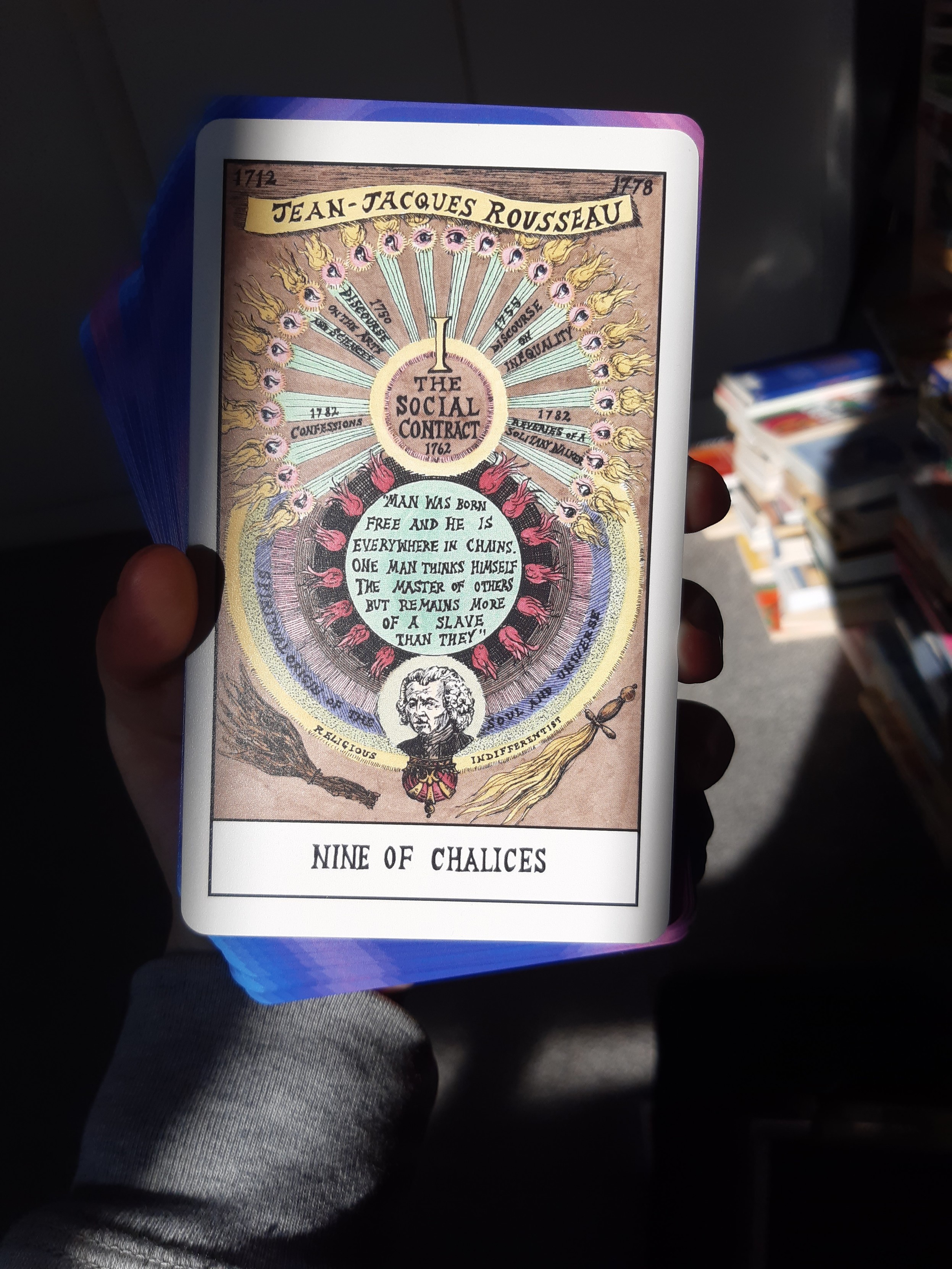
Attainment and contentment.
Rousseau's ideas seem kind of basic today but in the context of monarchy and generalized "because God said so" justifications making right, the idea that political power required the general consent of the people, and that no religion was necessarily more or less correct was disruptive enough that he was charged with blasphemy a few times. These ideas form the basis of the collective networking and autonomy that are to me the positive side of technological development.
Though, the Enlightenment/rationalism/empiricism always brings to mind the observation by Adorno in the introduction to the Dialectic of Enlightenment... many felt just shortly before that communism was empirically inevitable, and yet it didn't happen. Do you sit there continuing to insist it's inevitable, or do you try and figure out why it didn't happen? Sometimes it's possible to be a little too contented.
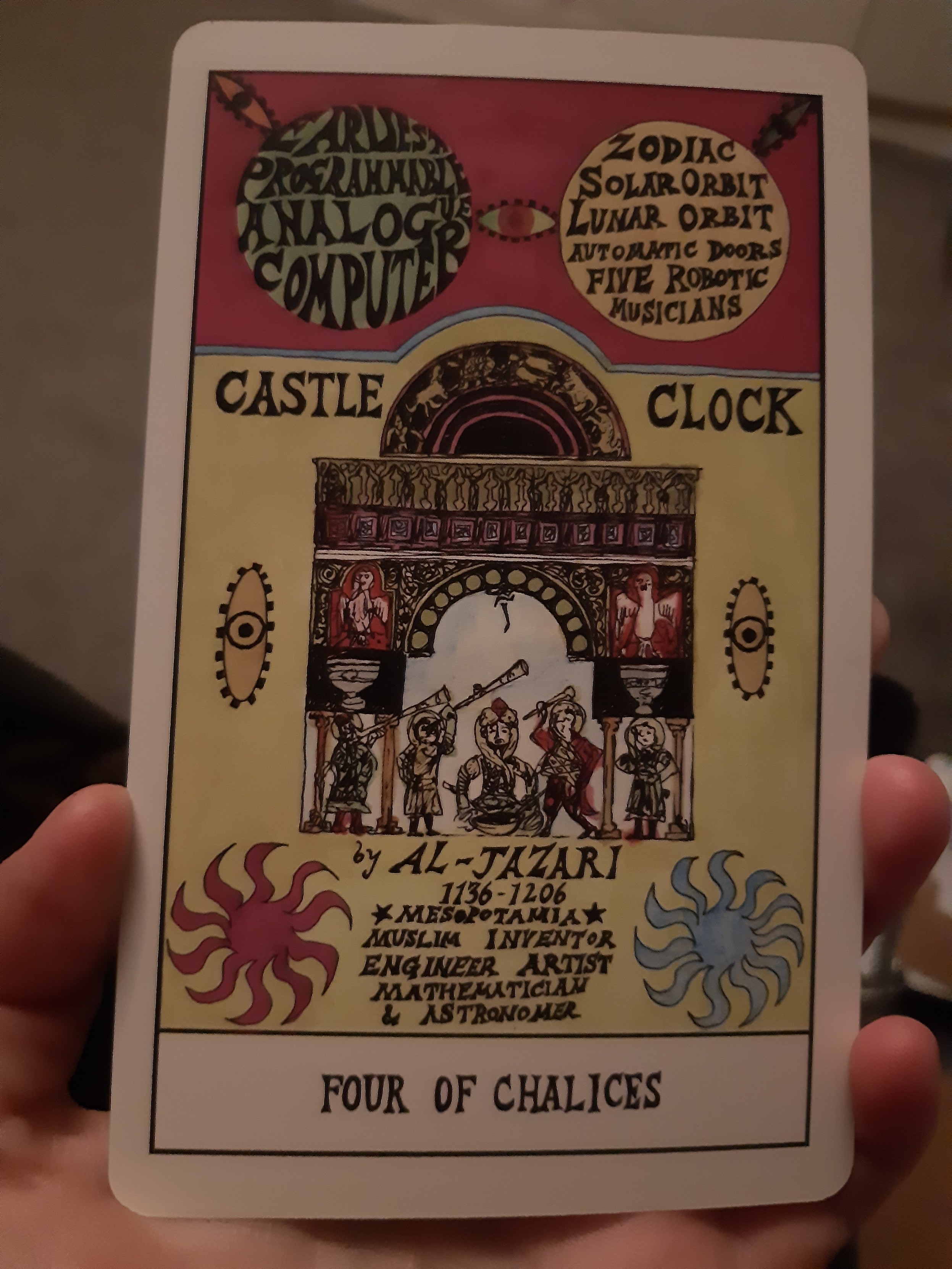
A card of contemplation, missed opportunities, and apathy...
Al-Jazari's castle clock is an interesting bit of history, because it comes so far before other things commonly cited as predecessors to computing or programming.
Early automata were focused on the creation of novelty and illusion, so in a way they represent an alternate path, where computing and automation aren't primarily directed towards financial optimization or biopolitical management. Though, naturally, from the view of a capitalistic society then, these programmable clocks and performing automatons become less impressive than industry "disrupting" automatic looms or calculation devices.
But also, early examples of analog computation and automation force us to reconsider exceptional claims about the supposedly special capabilities or social impacts of contemporary technology. Today, the news makes you want to shoot your phone, but at the Paris Commune, they turned their guns on the clocks...
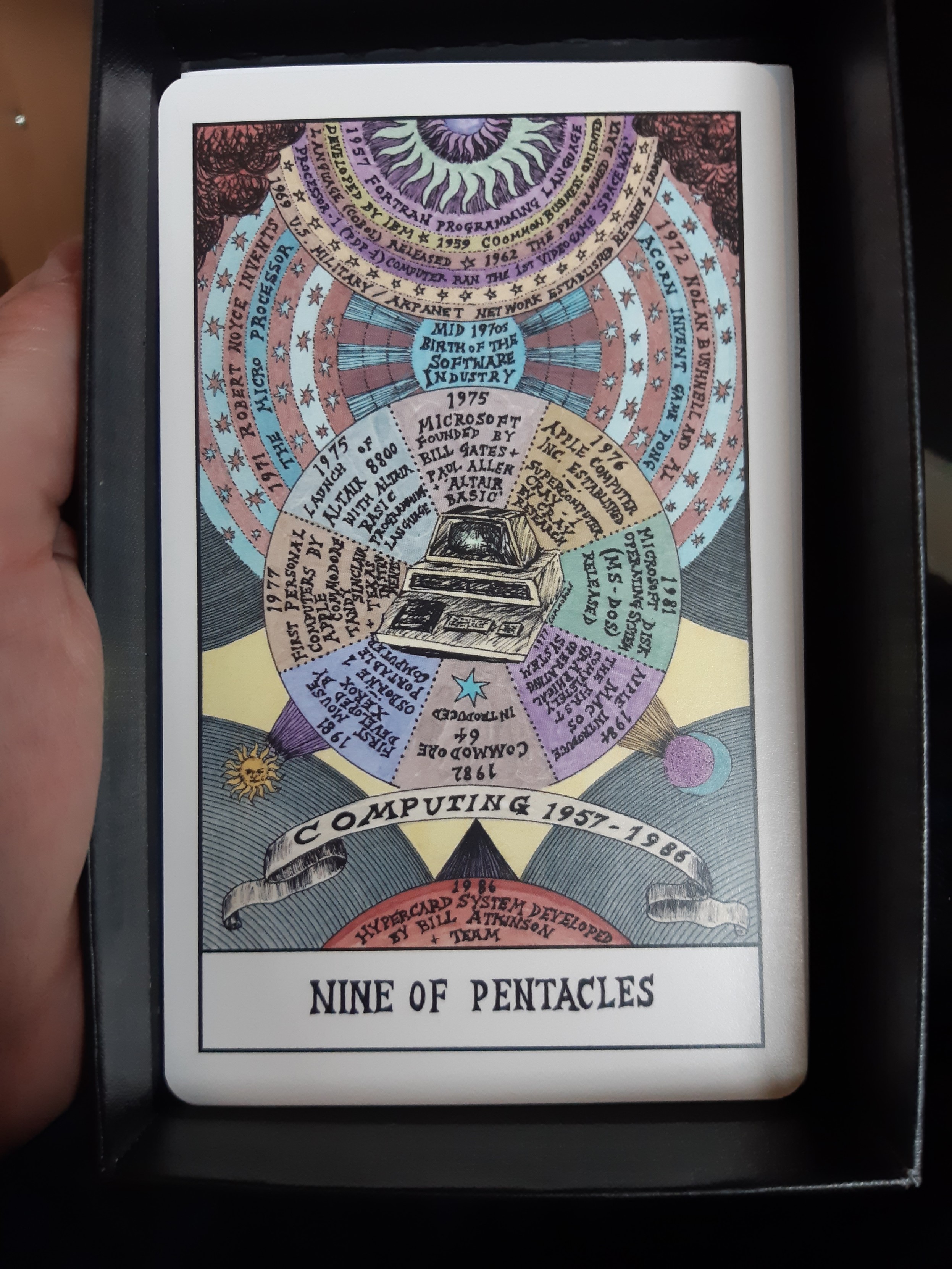
A card of luxury and freedom...
Of course it's the early era of personal computing... how couldn't it be? I didn't really become a regular computer user until about a decade after the period listed here, but the feelings are familiar to me... even with simple word processing or image editing programs it felt like there was so much you could do, so much capability that the computer represented that it was up to you to fulfill, and if it was connected to a printer or the internet, then there was an even more infinite horizon...
But we can see that some of the main players in bringing computers into peoples' homes, indeed a sort of luxury good that had many uses but no specific necessary purpose to a regular household yet, are also the main figures we now associate with computing being increasingly controlled by mandatory software licensing, updates, and planned obsolescence. As it went from being a luxury to being an unfortunate requirement for many aspects of education, job hunting and work it also offered less freedom in general, sometimes under the sinister guise of user friendliness...
I love my computer... I also try to keep it not necessary for some things it offers to take care of for me. Even if I have to stare at the "bad screen" all day for my job, I don't want the "good screen" to be my only other option... that makes the relationship with it less free. Though for some platforms (ie, Netflix declaring "sleep" their main competition) that seems to be their goal...

SORROW!! And nothing but it!
And MK-ULTRA is indeed an appropriate shout out for such a card. Even if a lot of the stuff it tried to make a case for, like controlling people through drugging, hypnosis, or subliminal messages ended up being kind of dubious (writing a novel partly about hypnosis now, it's amazing to see that there is still no consensus on like... what it actually IS lol much less if it is "real" or "works") these experiments were some of the most startling and high-profile examples of technology and scientific inquiry deployed in a way that treats consent and human dignity as basically a non-question, in favor of the view that it's something to totally control.
For all the instances of tech being pitched to us as liberatory, either in the sense of opening new capabilities or opportunities for connection or increasing convenience so we can, hypothetically, have more time to do what we want... is it possible to get away from the built in violations of consent, or the way endless tickboxes and "not right now" prompts wear down our ability to say no, draw a line, control how we use the tech rather than being used by it, so long as the state and capitalist control societies are the ones developing it?
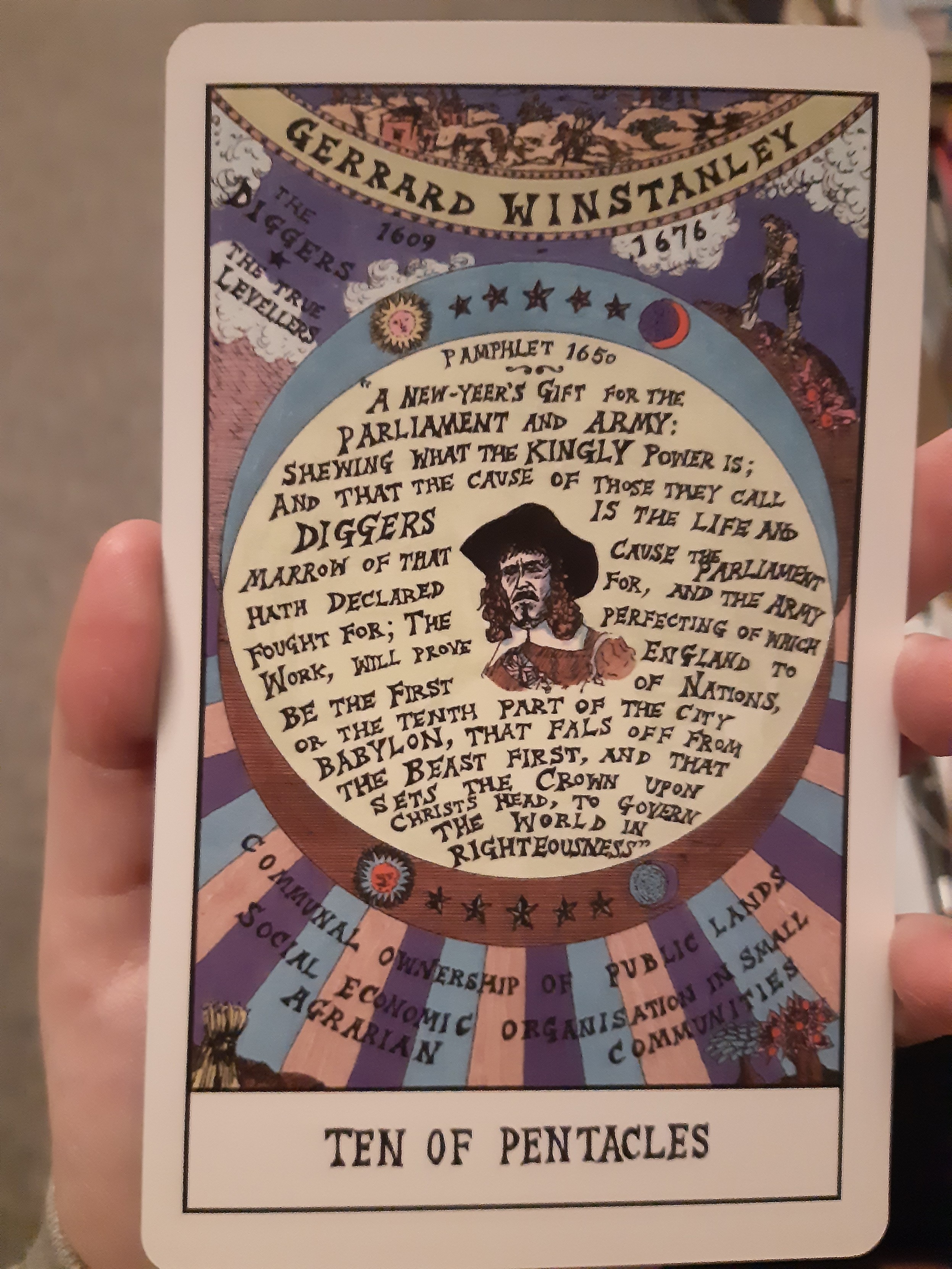
Foundations and security.
I was just thinking today that this project, despite all the ambivalent and bad features of the history of technology that this deck draws upon, has ultimately left me feeling more optimistic about technology than I think I was at the start. And this card is a good encapsulation of why.
Gerrard Winstanley founded the True Levellers or Diggers, who basically tore up hedgerows and plowed enclosed land to turn it back into common farmland, and would use this as an opportunity to experiment in communal subsistence farming. So much of technology, the web especially, has been enclosed into platforms that insist on holding values that don't appeal to me, and operate in ways that don't nourish me...
I think I will always have to scavenge, fight for my own small space, dig out a nook for myself in the corpse of "big technology," because the bigness has never served me, but the opportunities chipping away at it, investigating it, turning it around and using it for my own purposes to do cool stuff with others have offered are essential to the kind of person I am...
What can you dig up, plow through, or pull up from the roots to reclaim some space from these enclosed platforms? If a few more people do it here and there and over there, can we tear down all the walls that make their way of doing things so ubiquitous?

Potential, practicality, and opportunities in material concerns.
And these are kind of the big questions, right? Is there a way to make technology that isn't actively depleting resources and the biosphere-- a way that could even work with nature, supporting and restoring its processes? It feels so far from what we have now, but every new thing had to start somewhere.
Similar to interplanetary exploration, biodomes and terraforming have also kind of gotten a bad rep for, well, the people who would choose to continue burning up Earth's atmosphere for a slim chance of living on Mars.
Similarly I kind of cringe at the idea that Earth's environment needs us to save or rebuild it. Honestly, I am so inspired by the nature I see, even when it's struggling or changing... the trees that get blown over in windstorms but start sprouting from the trunk or growing sideways... the lichens that thrive in any crevice, and that's just around me in the city. Life can exist in strange situations and crazy extremes... why work against that for a sterile vision of the future?
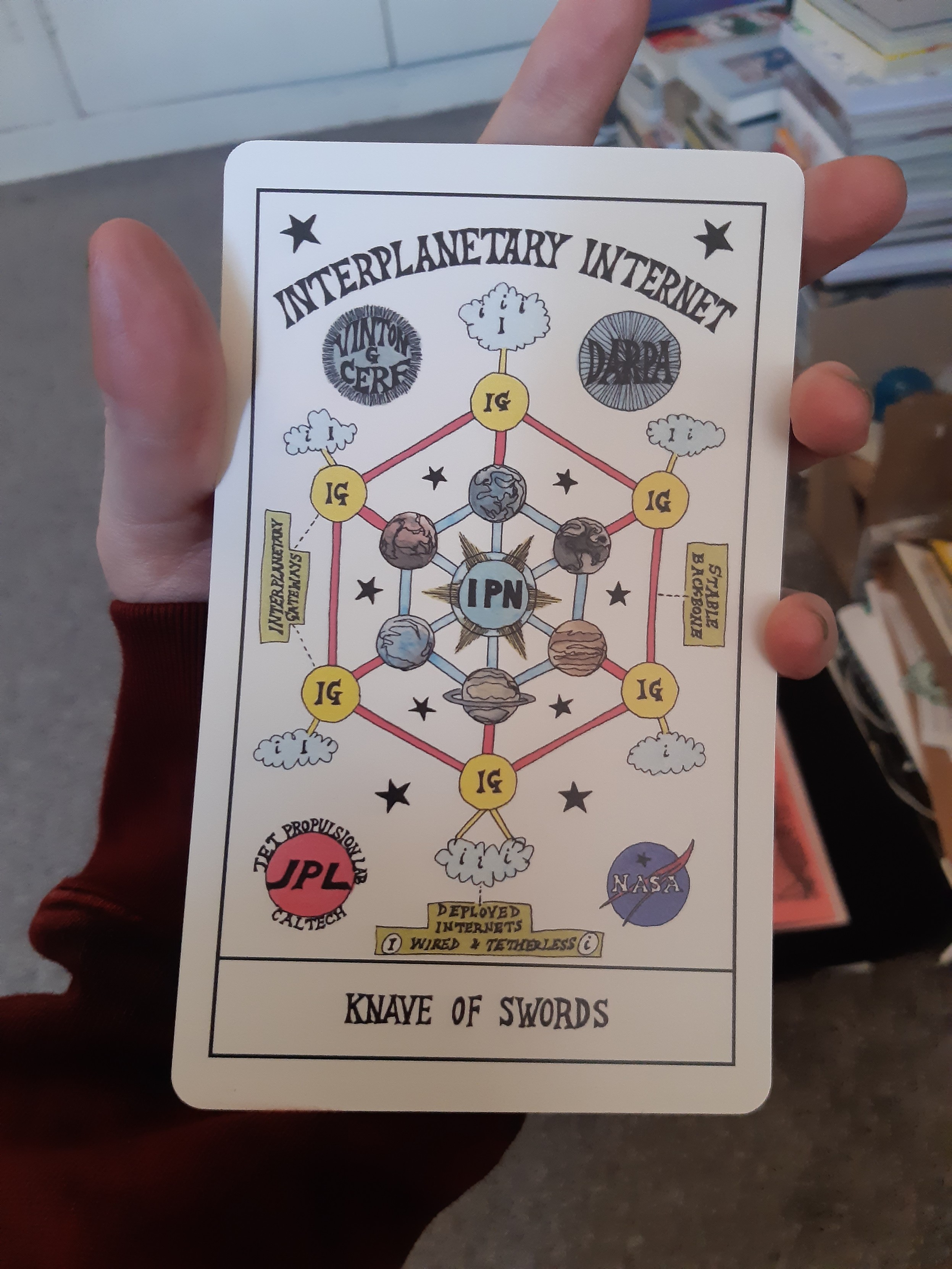
Energy, curiosity, new ideas and communication. Here represented by Interplanetary Internet.
This is funny, the whole justification for the space setting of the novella I just finished up writing was that Internet communication far out into the Solar System is too slow for AI drones to be faked in cube farms on Earth, so--
Thematically, something I also wanted to get at in it was how space exploration and space travel used to be this site of utopian optimism when I was a kid... We could show our best selves to the Star Trek style aliens. Now everyone has pretty much lost interest, assuming it'll just be crassly commercial, or that we have enough problems on Earth that it's not even worth thinking of...
Which is sad! The cosmists wanted to expand out into space as the solution to the contradiction between the finite resources on Earth and their ambition to resurrect all life that hadn't had the chance to experience utopia. Even though my own work is still mostly dystopian, there's something appealing about daydreaming of traveling out into space while still being connected to networks from home...
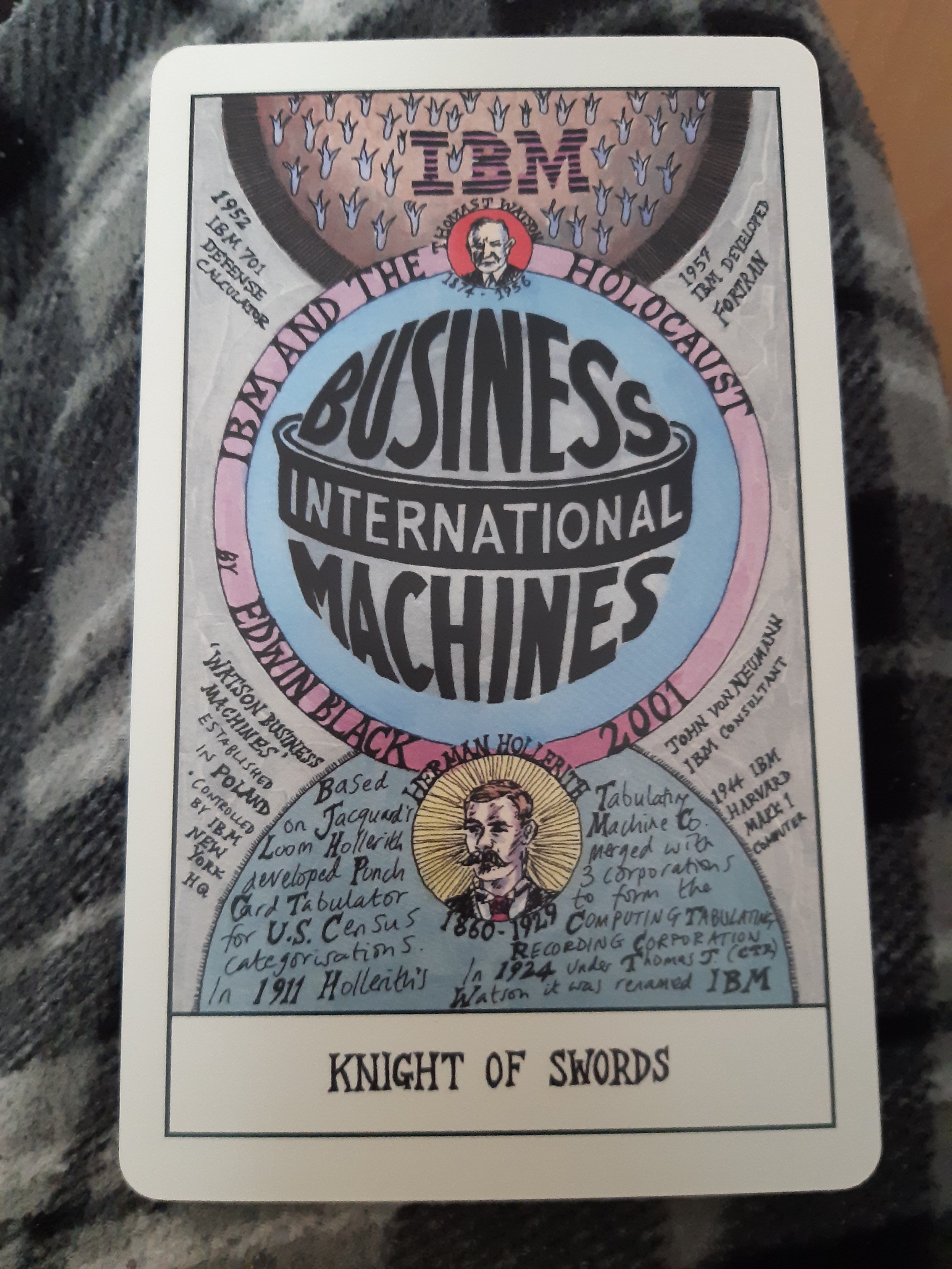
A card of action and determination, potentially to the point of being rash or warlike.
And here is IBM, along with all of its dirty laundry. The ultimate disruption of creating an international information society that didn't consider the worst possible effect, that it could be used in the administration of the holocaust.
Of course we're seeing it now in Farce Mode: useless startup and crypto tech grifters with no principles lining up to kiss the ring regardless of who is in the seat of the chief warmonger, ie, the US government... but it is the protean mercinariness of the idea that tech must both develop at any cost -and- be considered neutral, purpose ambivalent, and not the responsibility of its creators and boosters (or, then, anyone?) that got us here.
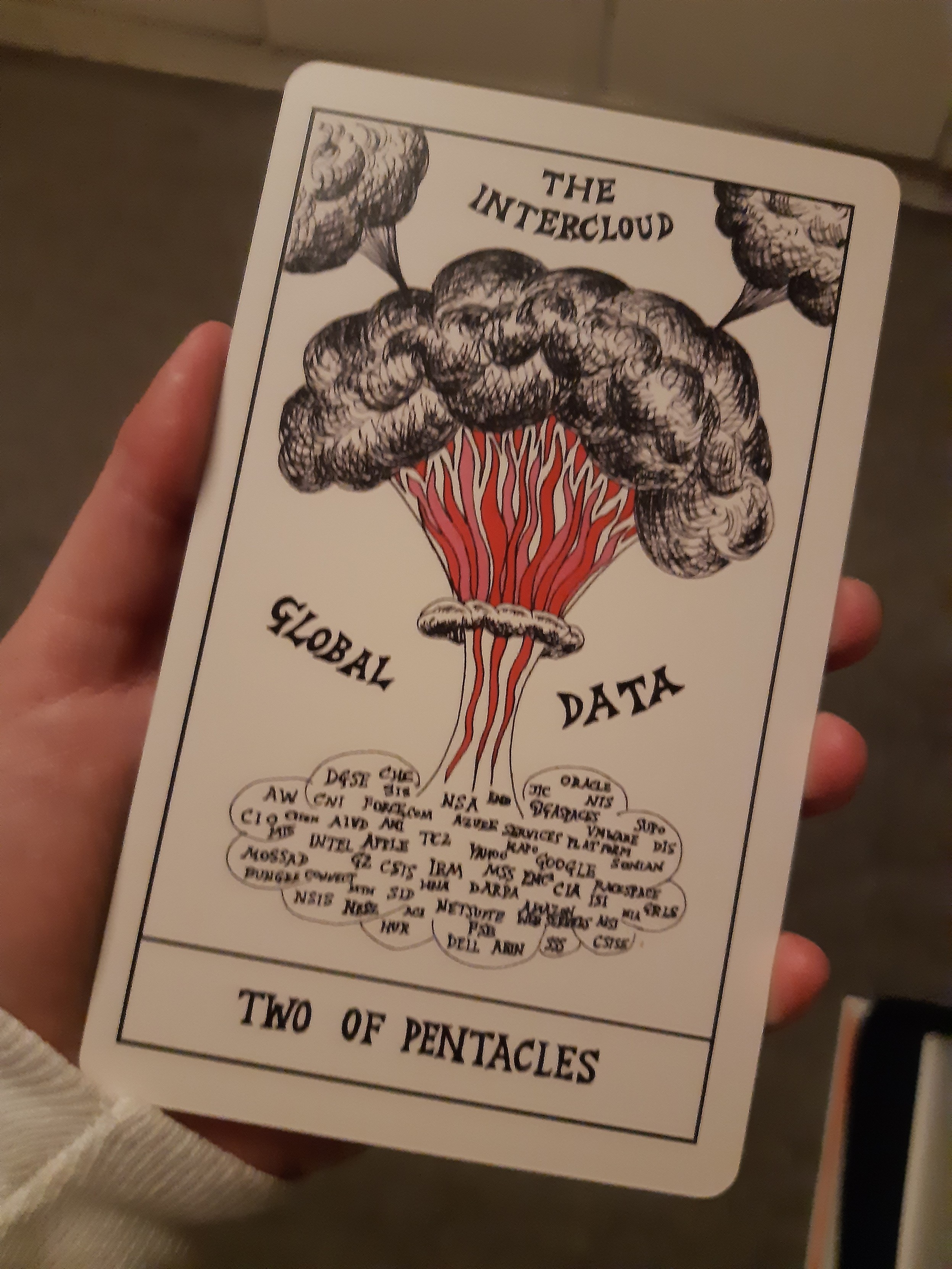
(So many pentacles... money money money). A card that represents adaptability and balance, flexibly responding to different situations or multiple demands.
And of course, what's more flexible now, possible to bend to so many different ends, fast-moving, and sometimes more desirable and worth more than cash-- data! And the Intercloud is the sort of anti-Whole Earth Catalog... the conglomerate of states and corporations that share data gleaned from surveillance and bureaucracy to be turned into policing and advertising... ugh.
The flexibility here is how amenable these things are to working together... think of all the times Google or Apple turned data over to police without even putting up a fight... without even needing to be asked... we may as well assume everything connected in this cloud is the same thing.
And the thing about this alienated, systematic data is that it doesn't really understand your particular life situation, and it hates ambiguity. In many cases I've found you have to act how the data expects to get through some form or new piece of data collection cruft, rather than giving them what's strictly "accurate." Adaptability goes both ways... but only one side has to show flexibility in response.
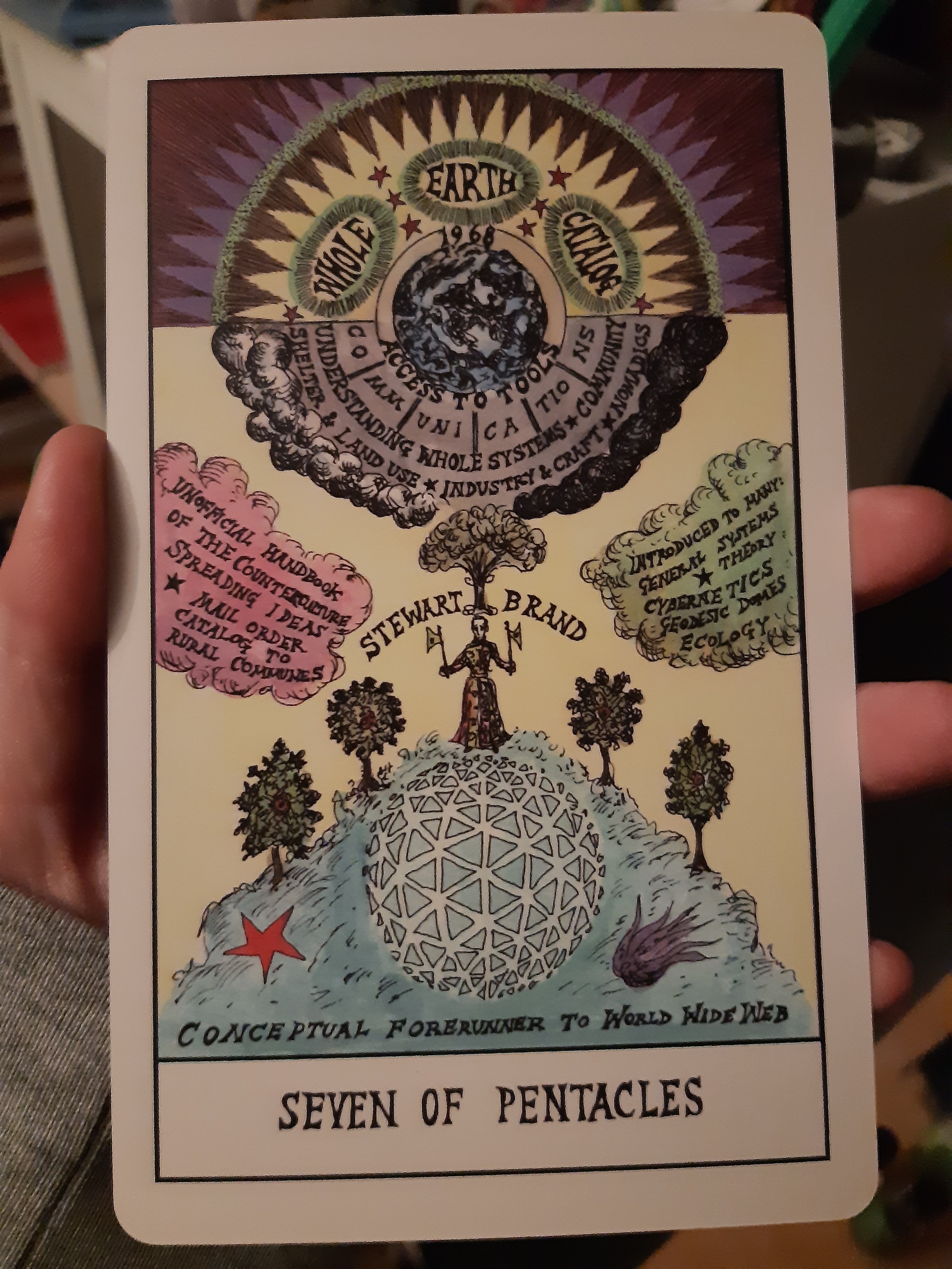
A positive vision of investment, seeing your goals, ideas and work finally bear fruit.
And it couldn't be a more beautiful card... The Whole Earth Catalog not only was the inspiration and dream of a living, accessible information infrastructure the internet was envisioned as, and can still, at its best moments, be... It contained so many ideas about distribution, handing people the tools they need, and empowering them to be able to DIY whatever crazy idea they wanted to run with.
This is not just the precursor of the parts of the internet that I love, and that I find make being an overly online weirdo occasionally worth it, but the source of many of my beliefs about zines, gamedev, art and culture in general. Unlike many of the last few cards, a card that made me happy to look at.

Wisdom and directness.
This feels like a kind of wryly ironic card... building on yesterday's card, talk about a real cybered-space. Though there's nothing -inherently- wrong with high tech capabilities for action at a distance, and, indeed, it's easy to come up with positive impacts it could have in accessibility, research, et cetera... much like every other form of tech financially underwritten by nation states and militaries, the very sight of them brings an immediate visual association with terror and death.
The objects themselves are innocent, though... some human being always is controlling them in an office somewhere, or inputting the coordinates, or writing the algorithm that decides their targets. Even when the technology is brought back from bombing the periphery to being used on the center, it only creates an occasional illusion of convenience or automated "magic," its actual function often being increasingly invasive surveillance and increased precarity. Instead of driving your car around making a series of food deliveries, you're managing six delivery drones at once for less cash and less protection from dissatisfied customers...

A very positive, action-y card. Progress towards the future!
Well... I have to admit I haven't actually read any Gibson... in part because the spatial metaphor for cyberspace and the resulting aesthetics and ideas around that don't really do much for me lol. I'm a documents freak!
The spatial metaphors in general seem to have become totally divorced from "the effect of networks" as well... VR has been reduced to either solitary gaming or being an awkward homunculus among people you already do work meetings with IRL and the metaverse is just a big stupid mall...
I feel like ultimately I'm always kind of dissatisfied with how technology and particularly the internet is depicted in realist or sf fiction... it's either this OTT realm of moral dissipation and darkness reefer madness style, or just like boring relitigation of the author's twitter arguments... neither of which really get at both the joy and agony this occasionally surreal experience has brought to my life... maybe the closest thing to a good internet novel or a good virtuality novel for me is Bernhard's Correction? lol sorry I'm being a bit of a buzzkill on this one... it's hard to think of fiction that has presented a really beautiful progressive dream of what the internet could be like.

An inevitable and total transformation, possibly painful, but not necessarily The End...
A lot of anti-tech sentiment seems to wish that we could just put certain things back in the box. But the world where the technology that provides connection and access to information was entangled by its maybe well-intentioned originators with military and surveillance culture, game theory and bombs, is the world we have.
I always found the PVP gimmick for MGSV's online mode to be weirdly inspiring... if we want to live in a world without the atomic bomb, it'll have to be one where we took them all apart with our own hands. And it'll be one where the knowledge that it was made at one time will also always be a thing. How we frame it is up to us... there is no going back. How terrifying, how wonderful.

A difficult situation, struggle, financial insecurity.
Infrastructure... precisely that thing it never feels like there's enough cash for. ESPECIALLY in tech, where it always flows towards hype and disruption rather than maintaining what already exists.
The Internet is so huge, has such great practical benefits, and is an important part of so many peoples' lives, that of course we want the infrastructure maintained, and there to be good governance... Maybe it was the hype of the Internet itself that allowed some of these early gestures towards standardization and productive ground rules to stick.
Though there are a ton of tech corporations involved, a surprising amount was also done via the US Department of Defense directly, and now a lot of the corporations (ex- Don't Be Evil Google, for example) are chipping away at the principles they once helped set up... Whose infrastructure? It's always tied to governance, and always ideological. Be careful who you go asking for cash when you're broke...

Intellectual drive, clarity, calling for authoritative action. A go-for-it type of thing.
Timothy Leary certainly was a sort of intellectually driven, though more of a “question authority” type. Likewise, looking it up, the Eight-circuit Model of Consciousness here is generally thought to have little actual scientific credibility. Still… what model of consciousness does? Despite being how all of our “information” comes to us, it’s kind of ambiguous what this thing actually is, much less if there’s any systemic patterns that determine how it works.
I find it kind of inspiring to contemplate a multi-part model of consciousness that is both inward and outward looking. Leary was also of a period where there was optimism about space exploration, and the possibility of making contact with other species, from Earth or beyond. Now we seem to find this idea kind of embarrassing, because the idea of explaining ourselves feels embarrassing. Which in a way is it’s own kind of constantly-reinforcing self-centeredness.
There’s nothing more self-centered in the irritating way than how psychedelics as self-help, a “miracle” mental illness cure, the one weird trick to go 10x or come up with that sick disruptive business deal or chill out your bitch wife, have kind of become mainstream now. It’s all very inward-looking to the point that there’s nothing besides inward-ness. What’s the point of a honed mind if you can’t, like the king of swords, point it outwards?
(NB: in the process of looking up info on Timothy Leary for this post, I learned about possibly the most unnerving edible ever invented.)
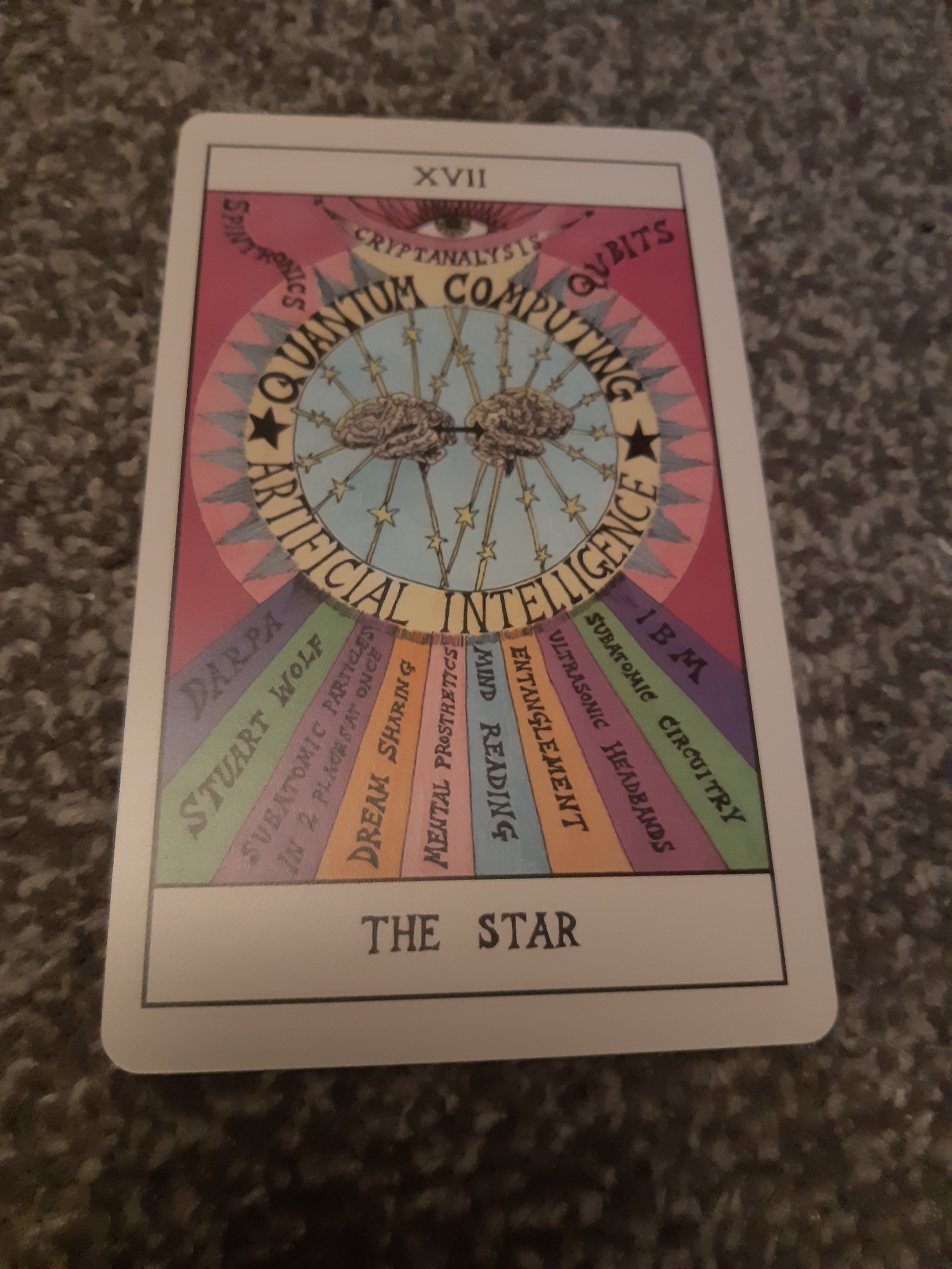
Hope, inspiration, future goals. A much more positive card than we've had so far!
But it's hard to feel positive about the massively exploitative and yet still totally underwhelming reality of artificial intelligence and quantum computing hype at the moment. The idea of an omnipotent computer, that could, indeed, simulate or work at an atomic or subatomic level, has kind of been the great dream of computing for a long time. It's almost a philosopher's stone type of thing.
Yesterday I reread this great essay on the current generative AI models by Hito Steyerl. She does a great job of going into how reliant these systems still are on human-made images, cleaned data, and ongoing human moderation at every level, but she also makes the observation that while their outputs masquerade as bits of text or images, which people wrongly attribute intention or creativity to, they're really statistical representations, with all of the inherent ideology and limitations of statistics baked in.
What would a truly intelligent computer capable of expanding our analytical powers and relieving the burden of tedious labor and the risks of incomplete information look like, and under what context would it be used to reinvent life towards more autonomy and joy rather than accelerating exploitation and control? Can we hope for such a thing with IBM and DARPA still in the picture...?
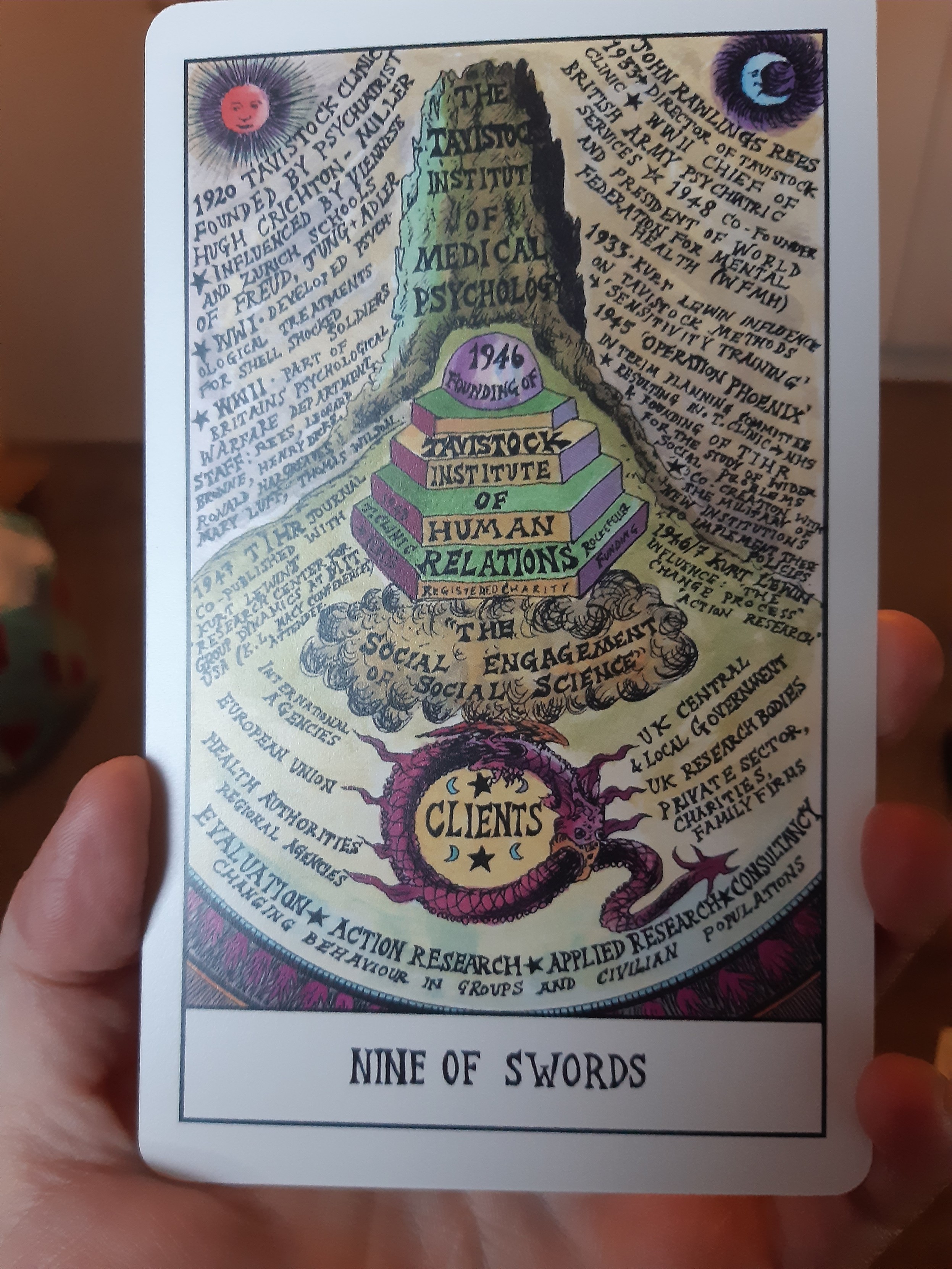
Following on from the feelings of overload and burden yesterday, this card represents nightmares and anxiety about the future.
Appropriately it's represented here by The Tavistock Institute of Human Relations, a UK governmental body established in 1946 that acted regionally, nationally, and internationally for “the social engagement of social sciences” or more bluntly, using theoretical methods to “change behavior in groups and civilian populations.”
Obviously the name Tavistock brings to mind the overbearing interference of the UK government in constantly trying to block any sort of trans care, or only dispensing it as a last resort after you’ve gone through years of waiting around and a thorough psychiatric probing. A population where everyone just conformed to the two standard cis gender roles would indeed be much easier to control, so to a “Labour” government obsessed with means testing, pathologizing and cutting benefits, it’s of course desirable to treat “normality” as a virtue and any difference as disease to eliminate.
I could talk about so many things, the awful CBT and soft conversion therapy I’ve personally received in the UK, how state surveillance and punishment disproportionately targets autistic people, how even punitive and inadequate psychological care is too hard to access, how outcomes are measured in “productivity” rather than happiness. A tendency that is not technic in the big machines or internet enabled devices way, but has infested every aspect of life as much as people fear tiktok attention spans have; people I want to ally with constantly crowing “just be normal” or getting sucked down a health and fitness grifthole.
An exhausting and sad card. I’ll be honest, I almost put it back when I pulled it lol. But obviously a big part of contemporary technological thought nevertheless.
In March 2025, I posted one card I drew from Suzanne Treister's Hexen 2.0 Tarot Deck per day of the month.


The deck consists of all the major and minor arcana depicted by alchemical drawings of people and things from the history of technology, or, more specifically, "the scientific underpinnings of what Michel Foucault called bio-political governance."
Why? Because I had to do some tech-related talks that month, and also with the dark side of tech being so blatant lately, I felt the need to think about it more, and explore my associations/values etc!

Starting with the 10 of Wands, typically representing overload, burden.
Here it is represented by a variety of early computing projects, many subsidized by their respective governments.
I think of how before a computer or calculator was a thing it was a job. Even after they existed, people still had to mediate, calculate, punch cards, interpret, etc. And in my own work I still often feel like a babysitter of inflexible computational quirks... why can't the spreadsheet software, or CMS, or database just do that mind-numbingly boring and burdensome stuff for me?
I also think how, even if it's built on what were once dull analog tasks, it's not -exactly- the same though, is it? In middle school computer lab I was taught a bit of BASIC, and being able to make a simple text "frogger" or branching adventure program, even if they were super rudimentary, was more compelling for some reason than imagining them or drawing them in a notebook... the sort of action at a delay/distance that computing offers, or that is computing's illusion...
































